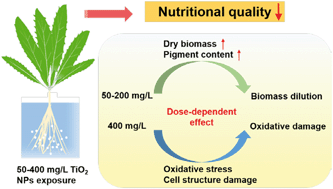当前位置:
X-MOL 学术
›
Environ. Sci.: Nano
›
论文详情
Our official English website, www.x-mol.net, welcomes your
feedback! (Note: you will need to create a separate account there.)
TiO2 nanoparticle exposure on lettuce (Lactuca sativa L.): dose-dependent deterioration of nutritional quality
Environmental Science: Nano ( IF 5.8 ) Pub Date : 2019/12/23 , DOI: 10.1039/c9en01215j Jing Hu 1, 2, 3, 4, 5 , Xinyi Wu 1, 2, 3, 4, 5 , Fan Wu 1, 2, 3, 4, 5 , Weixiao Chen 1, 2, 3, 4, 5 , Xinyu Zhang 1, 2, 3, 4, 5 , Jason C. White 6, 7, 8, 9 , Junli Li 5, 10, 11, 12 , Yi Wan 1, 2, 3, 4, 5 , Junfeng Liu 1, 2, 3, 4, 5 , Xilong Wang 1, 2, 3, 4, 5
Environmental Science: Nano ( IF 5.8 ) Pub Date : 2019/12/23 , DOI: 10.1039/c9en01215j Jing Hu 1, 2, 3, 4, 5 , Xinyi Wu 1, 2, 3, 4, 5 , Fan Wu 1, 2, 3, 4, 5 , Weixiao Chen 1, 2, 3, 4, 5 , Xinyu Zhang 1, 2, 3, 4, 5 , Jason C. White 6, 7, 8, 9 , Junli Li 5, 10, 11, 12 , Yi Wan 1, 2, 3, 4, 5 , Junfeng Liu 1, 2, 3, 4, 5 , Xilong Wang 1, 2, 3, 4, 5
Affiliation

|
Titanium dioxide nanoparticles (TiO2 NPs) are among the most widely produced engineered nanoparticles (NPs) and are used in a number of fields. However, the impact of the released TiO2 NPs on nutritional quality of edible vegetable crops and the associated mechanisms responsible for those changes are poorly understood. In the present study, lettuce (Lactuca sativa L.) was exposed to 50% Hoagland's nutrient solution amended with 0, 50, 100, 200, or 400 mg L−1 TiO2 NPs for one week. The results showed that TiO2 NPs exposure at 50–400 mg L−1 negatively impacted the nutritional quality of lettuce. Specifically, 50–400 mg L−1 TiO2 NPs significantly decreased the content of Ca by 33.6–35.7%, Mg by 7.1–27.2%, Mn by 21.0–34.5%, Fe by 8.6–21.0%, Zn by 11.8–22.6%, and B by 27.3–44.1% in lettuce edible tissues, relative to the control. However, 50–200 mg L−1 TiO2 NPs exposure significantly increased the root and shoot dry biomass by 0.69–1.3-fold and 32.0–75.6%, respectively; the contents of chlorophyll a, total chlorophyll, and carotenoid were increased by 14.7–24.5%, 10.3–18.5%, and 12.6–20.5%, respectively, relative to the control. The reductions in nutrient content under 50–200 mg L−1 TiO2 NPs exposure were correlated with the significant increase in plant biomass, suggesting that the changes were a function of the biomass dilution effect. Alternatively, the nutrient content reduction at 400 mg L−1 TiO2 NPs did not result from this mechanism since plant growth (dry biomass) was unchanged. Here, cell structure damage including root cell membrane shrinkage and a disordering of the thylakoid arrangement resulting from strong oxidative stress occurred, which negatively affected nutrient uptake and led to nutrient content decreases. In addition, TiO2 NPs were adsorbed on root surfaces, which could also inhibit both water and nutrient uptake. Importantly, μ-XRF mapping showed that TiO2 NPs exposure did not change the nutrient distribution pattern in exposed leaf tissues. The findings from this work highlight that TiO2 NPs exposure negatively impacts the nutritional quality of lettuce, although the mechanisms of plant response vary with exposure level of TiO2 NPs.
中文翻译:

生菜上的TiO2纳米颗粒暴露(Lactuca sativa L.):营养质量的剂量依赖性下降
二氧化钛纳米颗粒(TiO 2 NPs)是生产最广泛的工程纳米颗粒(NPs)之一,并用于许多领域。然而,人们对释放的TiO 2 NPs对食用蔬菜作物营养质量的影响以及造成这些变化的相关机理了解甚少。在本研究中,将莴苣(Lactuca sativa L.)暴露于50%Hoagland的营养液中,该营养液用0、50、100、200或400 mg L -1 TiO 2 NPs修正了一周。结果表明,暴露于50–400 mg L -1的TiO 2 NPs对生菜的营养质量产生负面影响。具体而言,50–400 mg L -1 TiO2个NP分别使Ca含量降低了33.6–35.7%,Mg降低了7.1–27.2%,Mn降低了21.0–34.5%,Fe降低了8.6–21.0%,Zn降低了11.8–22.6%,B降低了27.3–44.1%生菜的食用组织,相对于对照。然而,50-200 mg L -1 TiO 2 NPs的暴露显着增加了根和茎干生物量,分别增加了0.69-1.3倍和32.0-75.6%。相对于对照,叶绿素a,总叶绿素和类胡萝卜素的含量分别增加了14.7–24.5%,10.3–18.5%和12.6–20.5%。50–200 mg L -1 TiO 2下营养成分的减少NPs暴露与植物生物量的显着增加相关,表明该变化是生物量稀释作用的函数。备选地,由于植物生长(干生物量)未改变,因此该机理没有导致400 mg L -1 TiO 2 NPs的养分含量降低。在此,发生了由根氧化膜引起的细胞结构损伤,包括根细胞膜收缩和类囊体排列紊乱,这对养分吸收产生了负面影响,并导致养分含量下降。此外,TiO 2 NPs吸附在根部表面,这也可能同时抑制水分和养分吸收。重要的是,μ-XRF测绘表明TiO 2NPs暴露并没有改变暴露的叶片组织中的养分分布模式。这项工作的发现表明,尽管植物响应的机制随TiO 2 NPs的暴露水平而变化,但TiO 2 NPs的暴露对生菜的营养质量产生了负面影响。
更新日期:2020-02-20
中文翻译:

生菜上的TiO2纳米颗粒暴露(Lactuca sativa L.):营养质量的剂量依赖性下降
二氧化钛纳米颗粒(TiO 2 NPs)是生产最广泛的工程纳米颗粒(NPs)之一,并用于许多领域。然而,人们对释放的TiO 2 NPs对食用蔬菜作物营养质量的影响以及造成这些变化的相关机理了解甚少。在本研究中,将莴苣(Lactuca sativa L.)暴露于50%Hoagland的营养液中,该营养液用0、50、100、200或400 mg L -1 TiO 2 NPs修正了一周。结果表明,暴露于50–400 mg L -1的TiO 2 NPs对生菜的营养质量产生负面影响。具体而言,50–400 mg L -1 TiO2个NP分别使Ca含量降低了33.6–35.7%,Mg降低了7.1–27.2%,Mn降低了21.0–34.5%,Fe降低了8.6–21.0%,Zn降低了11.8–22.6%,B降低了27.3–44.1%生菜的食用组织,相对于对照。然而,50-200 mg L -1 TiO 2 NPs的暴露显着增加了根和茎干生物量,分别增加了0.69-1.3倍和32.0-75.6%。相对于对照,叶绿素a,总叶绿素和类胡萝卜素的含量分别增加了14.7–24.5%,10.3–18.5%和12.6–20.5%。50–200 mg L -1 TiO 2下营养成分的减少NPs暴露与植物生物量的显着增加相关,表明该变化是生物量稀释作用的函数。备选地,由于植物生长(干生物量)未改变,因此该机理没有导致400 mg L -1 TiO 2 NPs的养分含量降低。在此,发生了由根氧化膜引起的细胞结构损伤,包括根细胞膜收缩和类囊体排列紊乱,这对养分吸收产生了负面影响,并导致养分含量下降。此外,TiO 2 NPs吸附在根部表面,这也可能同时抑制水分和养分吸收。重要的是,μ-XRF测绘表明TiO 2NPs暴露并没有改变暴露的叶片组织中的养分分布模式。这项工作的发现表明,尽管植物响应的机制随TiO 2 NPs的暴露水平而变化,但TiO 2 NPs的暴露对生菜的营养质量产生了负面影响。











































 京公网安备 11010802027423号
京公网安备 11010802027423号